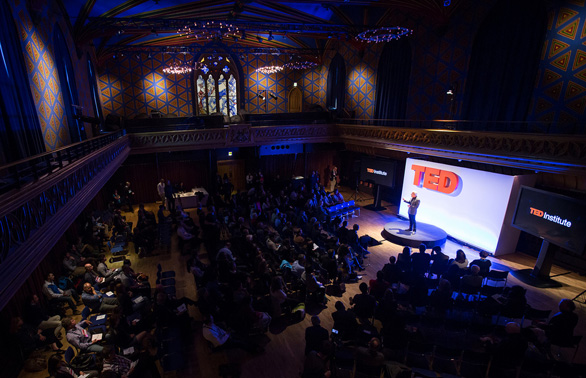
A look at the TED Institute theater. Photo: Ryan Lash
Losing a passport shortly before an international flight probably wouldn’t strike most people as an obvious moment to reflect upon alternative currencies. Jennifer Healey, a research scientist at Intel, would likely argue otherwise. She lost hers right before flying to TEDGlobal to speak at the TED Institute. Instead of panicking and melting down at immigration, she used the experience as a way to think about building a new form of economy based on the fair value exchange of our personal information. Healey imagined herself, sans passport, strolling without a care through customs into a foreign country. How might this work? By allowing that country to have unfettered access to a certain amount of her personal data — the accumulated digital footprint we leave behind every time we send an email, download an app, or search the Internet.
It’s a provocative idea in the wake of the recent NSA data-tracking revelations in the United States, and it’s one that prompted sparkling discussion after the TED Institute, a new program premiering at TEDGlobal 2013 that provides resources, ideas and support to any attendees and partners interested in trying to convey the TED ethos throughout their own organizations. TED’s corporate partners brought experts to address issues pertinent to business. The eight speakers led a two-hour session at the Hub – a converted gothic church towering over the city of Edinburgh — before TEDGlobal officially kicked off on Monday, June 12th.
Institute speakers discussed their own roles, and also drew on personal experience to help attendees get greater insight into tackling challenges within their own organizations. The speakers covered topics as varied as future scenario planning, digital education, and temperature-controlled buildings. Here are some of their insights:
Tokunbo Ajasa-Oluwa, the head of GoThinkBig, a new social impact initiative from O2, addressed the importance of mentorship, reminding the audience that, “talent doesn’t have a post code.”
Jeremy Bentham, Scenario team head at Shell, asked us to create “multiple memories of the future” using policy, technology, the markets, and other resources to avoid condemning ourselves to “the worst of both worlds” in the face of rising energy consumption.
Kate Groch, CEO of the Good Work Foundation, used the successful model of her digital, flexible schools in rural South Africa as an example of how Africa “no longer has to follow – it can leapfrog,” and revolutionize education systems around the world.
Chris Perretta, executive VP and CIO at State Street, a financial services holding company, asked the audience to imagine the process of manufacturing a car – and contrast it with the way financial services operate today. To build a car, you need workers with very specific sets of skills and knowledge. To redesign a car, you need workers who understand how the entire system fits together. He argued that these are the kind of deeply skilled workers who will also be in demand to work in complex industries such as finance and government.
Mahadev Raman, Director of Arup Group Limited, described the “comfort zone” temperature – the range of about ten degrees Celsius in which humans feel comfortable. We constantly heat and cool our buildings to reach this range, and the process accounts for one-fifth of our carbon dioxide emission. He advocated for architecture to consider the “performative aspect” of a building before focusing on its aesthetics.
Philippe Schulz, expert leader for the environment, energy, and raw materials at Renault SAS, shared the personal story of working for oil company Total. Realizing that it was impossible to change the firm’s harmful environmental practices from the inside, he suffered a crisis in confidence, and is now senior manager in Renault’s corporate planning department.
Tom Wujec, Fellow at Autodesk, ended the session with a reminder that “our raw potential to generate new ideas is probably no greater than Leonardo’s or Virgil’s, but we can leverage our creativity through new technologies.” Design allows us to interrogate the world, he said, and it is the medium that unites our creative potential with advancements in technology.
For many years, our corporate partners have designed exhibits for social spaces within TED Conferences. They have held collaborative workshops, and hosted dinners. Now we are excited to help our partners and TED Institute attendees bring some of the TED spirit back to their own organizations.
Comments (8)
Pingback: 5 Sure-Fire Ways to Differentiate Your Diversity Training – Nicolas 360
Pingback: Coming out in a TED Talk? That was hard. Watching the talk with my co-workers? Even harder. | MyWebspace
Pingback: Coming out in a TED Talk? That was hard. Watching the talk with my co-workers? Even harder. | BizBox B2B Social Site
Pingback: Coming out in a TED Talk? That was hard. Watching the talk with my co-workers? Even harder. - Social Nurse Web
Pingback: Coming out in a TED Talk? That was hard. Watching the talk with my co-workers? Even harder. - Rixal Communications | Custom Media & Advertising | Media. Solved. | Rixal.com
Pingback: getAbstract Branches Out Beyond Business Books with TED Summaries - Sexy N Hot Clothes
Pingback: What happens when employees give TED Talks? A look at TED@StateStreet | Health & Wellness Chicago
Pingback: getAbstract Goes Beyond Business Books with TED Summaries | getAbstract Blog